
Detailed Guide to the Best Evaporative Portable Coolers
Why Evaporative Portable Coolers Are the Smart Cooling Choice
Evaporative portable coolers offer an energy-efficient, eco-friendly alternative to traditional air conditioning that can reduce temperatures by up to 30°F while using as little as $1 of electricity per day. These natural cooling systems work by drawing hot air through water-soaked pads, where evaporation removes heat and delivers refreshingly cool air.
Quick Answer for "Evaporative Portable" Searches:
- What they are: Portable cooling devices that use water evaporation to cool air naturally
- Best climates: Hot, dry areas with humidity below 60% for optimal performance
- Coverage: 200-3,000+ sq ft depending on CFM rating (2,000 CFM ≈ 500 sq ft)
- Energy use: 75% less electricity than traditional AC units
- Cost: $100-$5,000+ depending on size and features
- Key benefit: Chemical-free cooling that adds beneficial humidity in dry climates
The science behind evaporative cooling uses the same natural process your body uses when you sweat. When hot, dry air passes over water-saturated cooling media, the highest-energy water molecules evaporate first, taking heat with them and leaving cooler air behind.
Modern portable evaporative coolers have evolved far beyond basic "swamp coolers." Today's units feature smart controls, whisper-quiet operation (often under 60 dB), and advanced media technology that maximizes cooling efficiency while minimizing maintenance. Some models include Wi-Fi connectivity and patent-pending designs that allow wall-hugging placement without compromising airflow.
As American Mortuary Coolers, a national-level mortuary cooler supplier with experience in commercial cooling solutions, we've seen how evaporative portable units provide reliable, cost-effective climate control for specialized applications where durability and efficiency matter most.
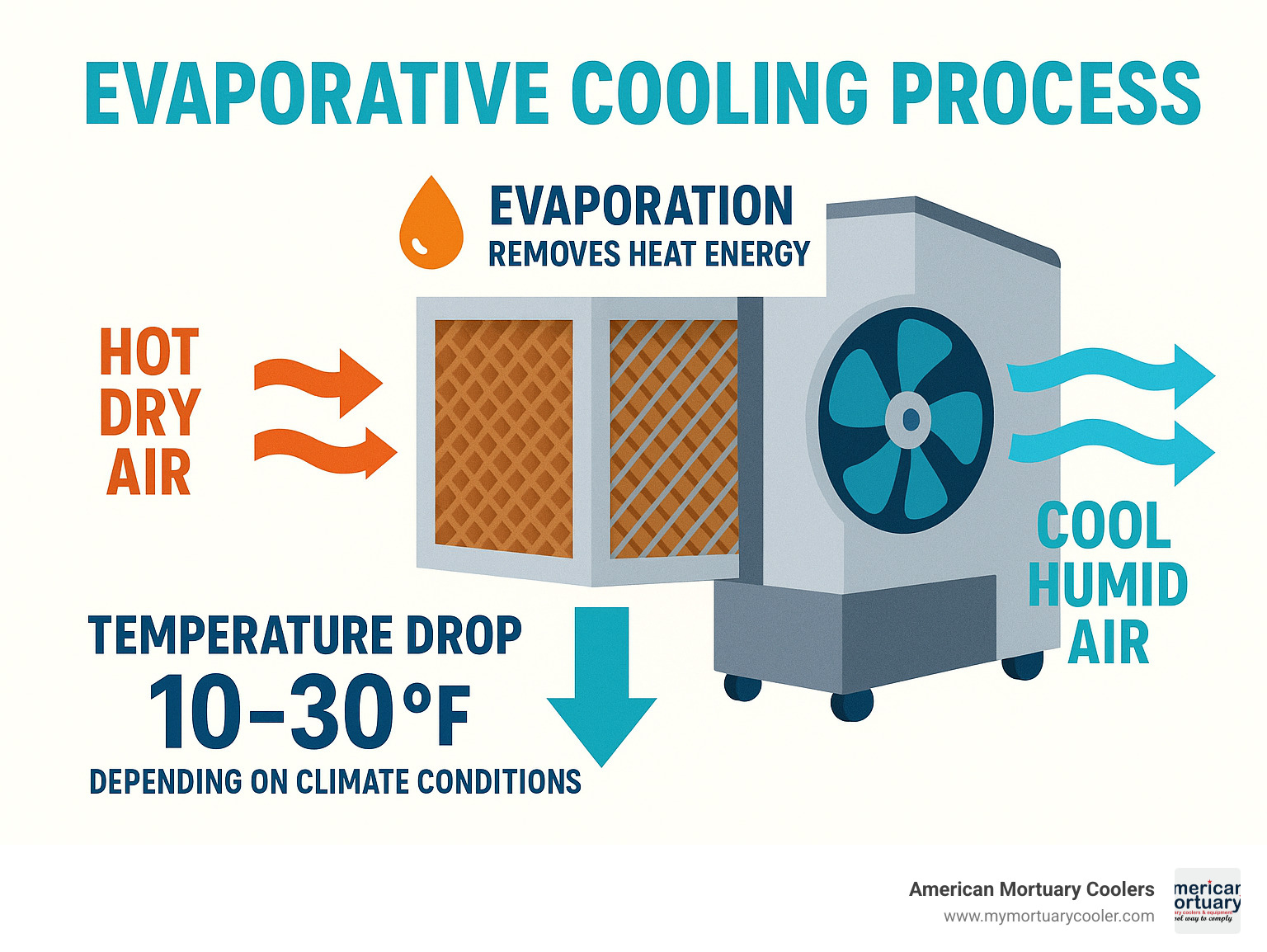
Evaporative portable terms you need:
How Do Portable Evaporative Coolers Work?
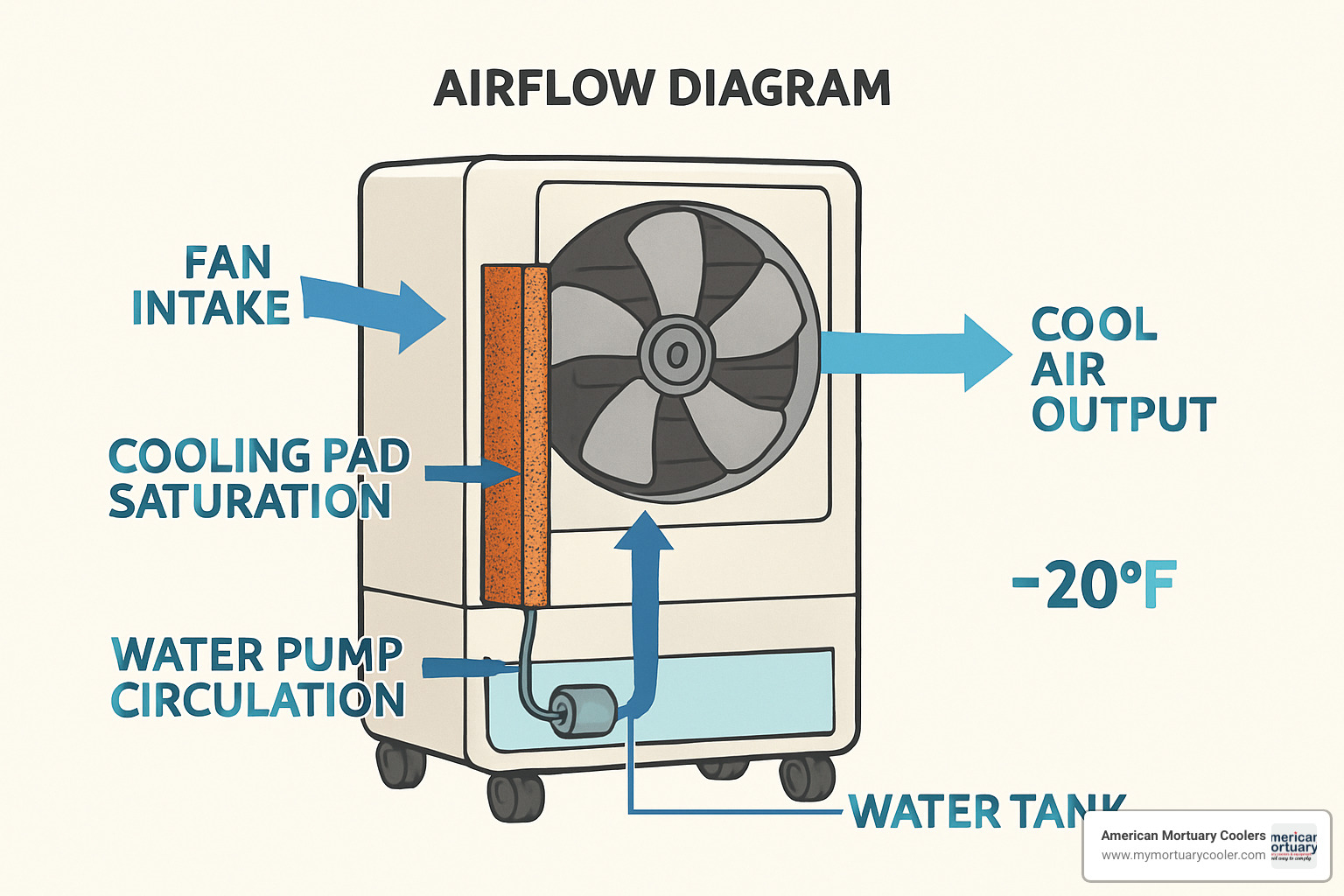
Think of an evaporative portable cooler as nature's own air conditioner. Hot, dry air gets pulled into the unit by a powerful fan, then passes through water-soaked cooling pads. As the hot air moves through these wet pads, water absorbs heat energy and transforms into vapor. This endothermic reaction naturally cools the air before it gets blown back into your space.
Scientific research on climate suitability shows that these coolers perform best when humidity stays below 60%. In perfect hot, dry conditions, you can see temperature drops of up to 15°F.
The CFM rating tells you how much air the unit can move. A typical evaporative portable unit pushing 2,000 CFM can handle about 500 square feet effectively.
Components & Airflow Path
Every evaporative portable cooler has four main parts working together.
The fan system moves air using typically just 32 to 300 watts compared to thousands that traditional AC units consume. Modern units come with variable speed controls for optimal comfort.
The water pump keeps water flowing from the tank to the cooling pads, ensuring even water distribution for better cooling performance.
Water reservoir sizes vary from 1.2-gallon tanks on personal units to 13+ gallon tanks on larger models. Many units feature top-fill ports, removable tanks, or hose connections for continuous operation.
The cooling pads are where evaporation occurs. Today's advanced materials like HydroTek™ evaporative media outperform old wood wool pads with better water absorption and airflow efficiency.
Direct vs Indirect Systems
Most evaporative portable coolers use direct evaporation, where air passes right through wet pads. This adds moisture to your air, which is beneficial in dry climates.
Indirect systems use heat exchangers to cool air without adding moisture. They're more complex and expensive but can work in more humid climates where direct evaporation might feel muggy.
Performance Metrics
Air velocity shows how effectively cooled air reaches you. Units like the Portacool APEX 500 can push air at 40 MPH and reach 55 feet away.
Coverage area ratings assume perfect conditions. For outdoor use, expect about 25-35% of the rated indoor coverage.
Noise levels in quality units stay at 60 dB or quieter. Premium models operate at just 53 dB - quieter than normal conversation.
Water consumption typically runs 1-5 gallons per day depending on conditions and fan speed.
Choosing the Right Evaporative Portable Cooler
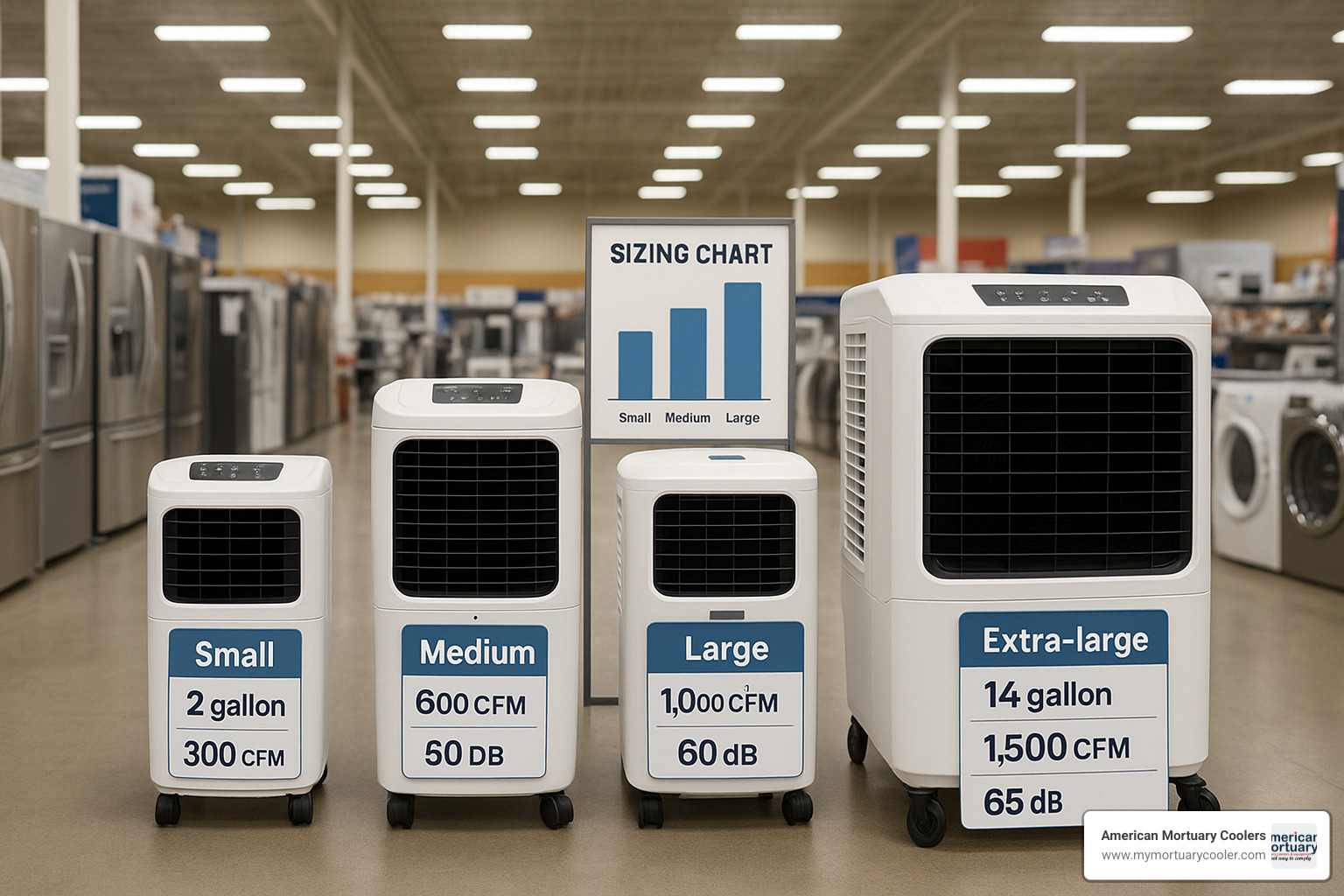
Finding the perfect evaporative portable cooler comes down to matching your specific situation with the right features.
Your local climate is the biggest factor. These units shine in dry climates where humidity stays below 60% during the hottest parts of the day. Think Arizona, Nevada, or eastern Colorado - places where the air is thirsty for moisture.
Portability features matter more than you might think. Look for sturdy caster wheels, cord storage, and balanced weight distribution. Even hefty units like the Portacool APEX 500 include thoughtful touches like oversized back wheels.
Modern technology includes Wi-Fi enabled units that let you start cooling remotely, plus digital louver control and maintenance alerts sent to your phone.
For a complete breakdown, check out our comprehensive checklist for choosing the best portable air cooler.
Determining Coverage & CFM for an "evaporative portable"
The golden rule for sizing is to take your room's cubic footage and divide by two. That gives you the CFM rating you need.
A 20×25 foot workshop with 8-foot ceilings equals 4,000 cubic feet. Divide by two, and you need 2,000 CFM. This matches industry standards showing that 2,000 CFM units handle about 500 square feet of indoor space.
Outdoor use is different - without walls to contain cool air, your effective coverage drops to about 25-35% of the indoor rating.
High ceilings require proportionally bigger units. If your ceiling is 12 feet instead of 8, you've got 50% more air to cool.
Key Features to Prioritize in an "evaporative portable"
Tank size balances convenience with mobility. Bigger tanks mean longer run times but heavier units. For stationary use, choose 10+ gallon tanks. For portability, find the sweet spot between capacity and weight.
Fill options include removable tanks, top-fill ports, and hose hookups for continuous operation without refills.
Noise levels in quality units max out around 60 dB, with premium models hitting 53 dB or quieter.
Oscillating louvers spread cool air around instead of blasting one spot. Digital louver control lets you aim airflow precisely.
Convenience features like remote controls, timers, and low-water alarms protect your investment and improve usability.
Advanced Tech: Smart & Wall-Hugging "evaporative portable" Designs
Modern evaporative portable coolers pack serious technology into user-friendly packages.
CoolSync™ Wi-Fi connectivity puts complete control in your pocket. The Portacool app shows how intuitive this technology has become.
HydroTek™ evaporative media represents a major efficiency leap. Scientific research on media efficiency shows these improvements can boost cooling performance by 15-20% compared to standard materials.
Space-saving innovations like wall-hugging designs solve placement problems. Patent-pending front-air intake designs let units operate effectively against walls, freeing up valuable floor space.
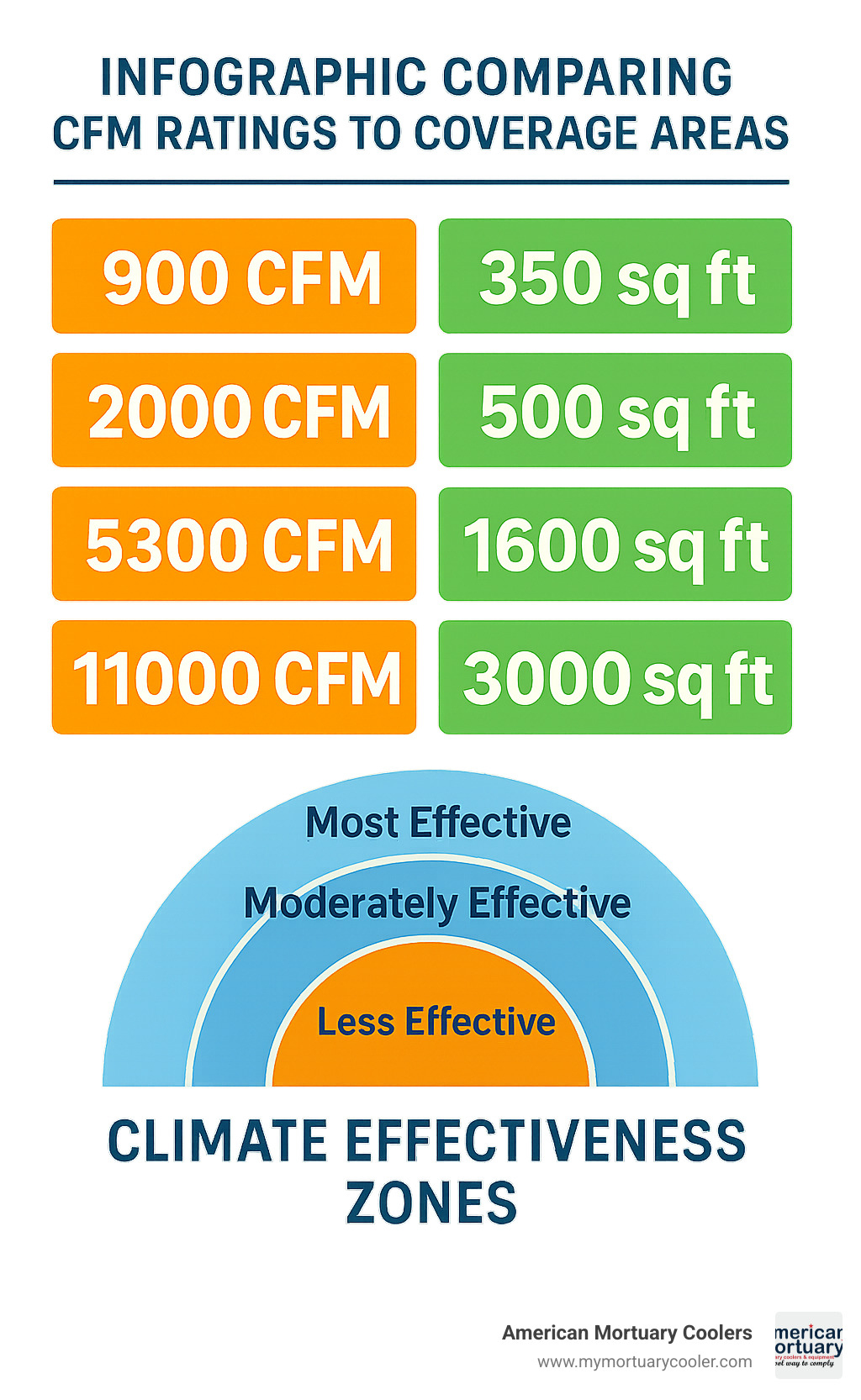
Setup, Maintenance & Safety Tips

Getting your evaporative portable cooler running properly starts with understanding that unlike regular air conditioners, these units work better with a little ventilation. Your unit adds moisture to the air, and that humid air needs somewhere to go.
Water quality makes a huge difference. Hard water with minerals will clog cooling pads faster. If your tap water leaves white spots on dishes, consider using distilled water or adding a simple inline filter.
For detailed maintenance strategies, check out our complete guide to choosing a cooler portable air conditioner.
Step-by-Step First Use
Unbox carefully and check for shipping damage. Look for cracks in housing or bent fan blades.
Rinse cooling pads even though they're new to remove manufacturing dust and packaging residue.
Fill the reservoir slowly while watching for leaks. Run the pump briefly to prime the system - you should see water flowing to all cooling pads evenly.
Plan your ventilation by opening a window or door about 1-2 inches for every 1,000 CFM your unit produces. This lets humid air escape while drawing in fresh, hot air for cooling.
Start on low speed and work your way up to find the sweet spot between cooling power and noise level.
Routine Care Schedule
Daily attention during heavy use means checking water levels and ensuring all cooling pads stay wet. Dry spots indicate pump problems or clogged pads.
Weekly maintenance involves draining old water completely and refilling with fresh water. Stagnant water breeds bacteria and creates odors. Check cooling pads for mineral buildup and clean debris from air intake screens.
Monthly deep cleaning requires removing cooling pads for thorough rinsing. In hard water areas, soak them in mild vinegar solution to dissolve mineral deposits. Clean the reservoir with weak bleach solution (one tablespoon per gallon), then rinse thoroughly.
Seasonal preparation at cooling season's end involves draining every drop of water, cleaning all components, and storing cooling pads in a dry place.
Annual pad replacement is inevitable - cooling pads typically last 3-6 months depending on water quality and usage.
Safety Considerations
Electrical safety starts with GFCI-protected outlets, especially in damp areas. Keep all connections dry and inspect cords regularly.
Tip-over protection comes built into many units as automatic shut-off switches. Don't disable these safety features.
Child and pet safety requires keeping units out of reach. Water reservoirs and moving fan blades can pose risks.
Avoiding over-humidification protects indoor air quality. Monitor humidity levels and maintain proper ventilation to prevent mold growth.
Water treatment becomes important in areas with poor water quality. Consider treated or distilled water to prevent bacterial growth. Never add chemicals, fragrances, or other additives unless manufacturer-approved.
As American Mortuary Coolers, we understand the importance of reliable cooling equipment that operates safely day after day. These maintenance practices will keep your evaporative cooler running efficiently while protecting your investment.
Leading Brands, Models & Cost Comparison
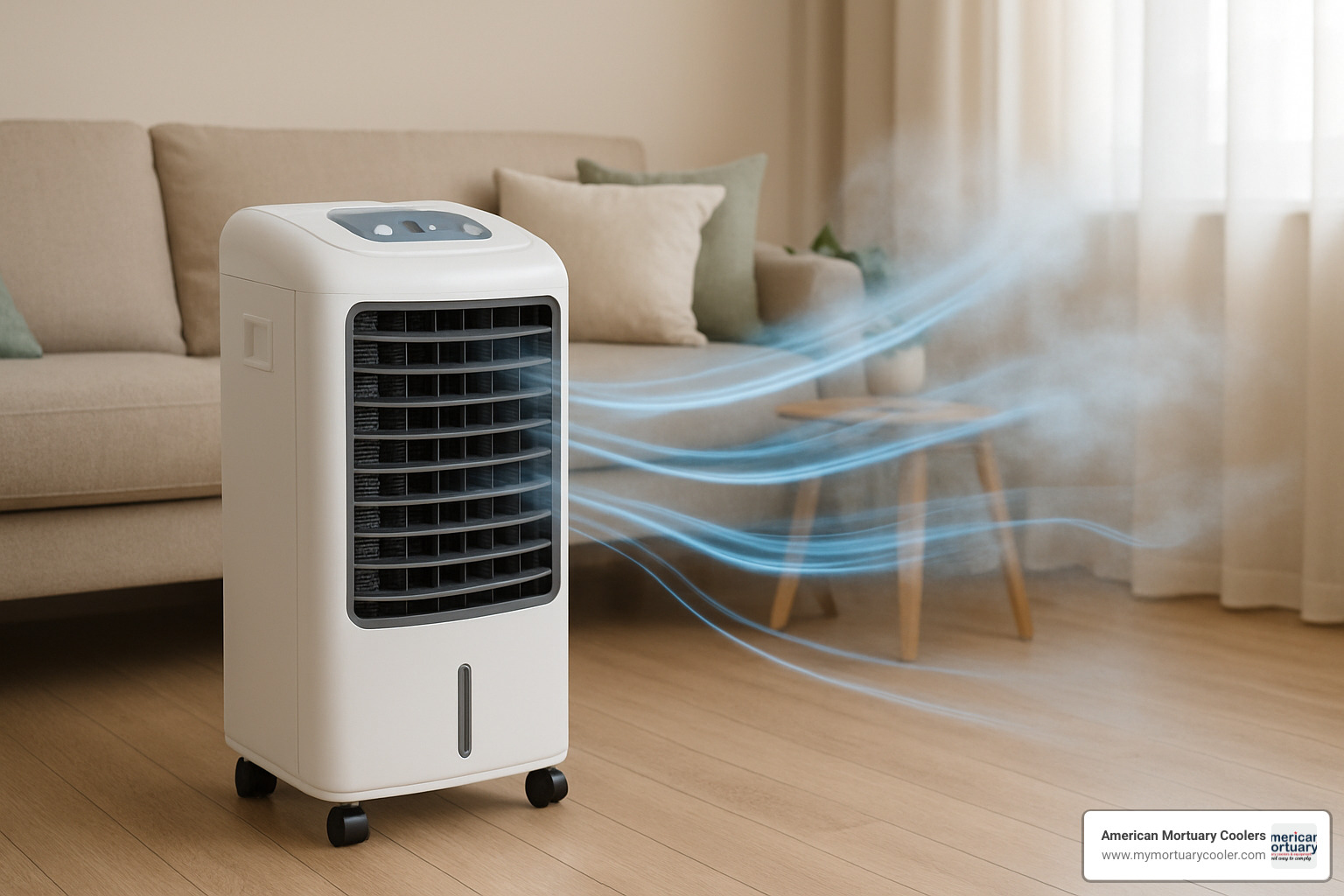
The evaporative portable cooler market spans from compact desktop units under $100 to industrial powerhouses exceeding $5,000. The sweet spot for most applications falls between $200-$1,500.
Portacool leads the premium market. Their APEX 500 cools 500 square feet with air reaching 55 feet away, operating at whisper-quiet 53 dB. CoolSync™ Wi-Fi controls let you start cooling remotely. At roughly $1 per day in electricity costs, the value proposition is compelling.
Honeywell dominates home cooling with models like the CL202PEU that function as cooler, humidifier, and fan. With 700 CFM covering up to 430 square feet, plus features like ice compartments and low-water alarms, these units offer reliability without complexity.
Hessaire provides excellent value in the middle market. Their lineup runs from 900 CFM units for smaller workshops to massive 11,000 CFM industrial units. The 3,100 CFM model hits a sweet spot for larger spaces without premium pricing.
Big Ass Fans brings industrial muscle with their Cool-Space series. When you need to cool 6,500 square feet with 24,000 CFM of airflow, these units deliver commercial-grade performance.
Operating costs tell an important story. Evaporative portable coolers typically use 75% less electricity than comparable air conditioning. While traditional AC might cost $5-$15 daily, most evaporative units run for $0.50-$1.50 per day.
Spotlight on Budget-Friendly Picks
Personal and desktop units under $300 serve individual workspaces with 200-600 CFM covering 50-150 square feet. Many weigh less than 15 pounds and include LED lighting, multiple speeds, and 6-9 hour runtime.
Small room coolers in the $100-$400 range handle residential needs with 1,000-2,000 CFM capacity, cooling 300-500 square feet with features like oscillating louvers and remote controls.
Mid-size portable units from $200-$800 are workhorses for larger rooms and small commercial spaces, featuring 2,000-5,000 CFM capacity with digital controls and robust construction.
High-Performance Industrial Options
Large portable units in the $800-$2,000 range feature 5,000-10,000 CFM capacity for cooling 1,500-3,000 square feet. Built for commercial use, they include continuous water fill connections, heavy-duty casters, and extended warranties.
Industrial and commercial systems above $2,000 serve the biggest cooling challenges. Units like the Big Ass Fans Cool-Space 500 with 24,000 CFM capacity handle large industrial spaces, outdoor events, and commercial applications with advanced controls and weather-resistant construction.
The key to smart shopping is matching capacity to your actual needs. Focus on CFM ratings that match your square footage, then compare features and build quality within that range.
Frequently Asked Questions about Evaporative Portable Coolers
After years of helping customers find the right cooling solutions, we've heard the most common questions about evaporative portable coolers. Let's tackle the big three that determine whether these units are right for your situation.
Do evaporative portable coolers work in humid climates?
Evaporative portable coolers shine brightest in hot, dry climates where humidity stays below 60%. But they're not useless everywhere else.
In moderately humid areas (around 70% humidity), you can still expect 5-10°F temperature drops plus increased air circulation comfort. The key is timing - run your unit during the driest parts of the day when temperatures peak but humidity often dips.
Consider pairing your evaporative cooler with a dehumidifier in consistently high humidity areas. This approach lets you enjoy energy savings and natural cooling benefits while keeping moisture levels comfortable.
For humid climates, focus on personal cooling zones rather than conditioning entire rooms. Position the unit to blow directly on your work area. You'll feel significantly cooler even if room temperature only drops a few degrees.
Manage your expectations in humid areas, but don't write off evaporative cooling entirely. The air movement alone provides comfort.
How much area can one evaporative portable unit cool?
Coverage depends on your specific situation, but CFM (Cubic Feet per Minute) is your key number - it tells you how much air the unit can move.
For indoor spaces: 200 CFM handles about 50 square feet (desk area), while 2,000 CFM can cool around 500 square feet of well-insulated space. Units with 5,000 CFM tackle 1,250 square feet, and industrial models with 10,000+ CFM handle spaces over 2,500 square feet.
Outdoor applications expect about 25-35% of the indoor rating for coverage. That 2,000 CFM unit cooling 500 square feet indoors might only effectively cool 125-175 square feet of patio space.
Higher ceilings mean more air volume to cool. Poor insulation lets cool air escape. Heat sources like equipment or lighting add to the cooling load.
It's better to slightly oversize your unit than struggle with inadequate cooling.
What is the difference between an evaporative portable cooler and a portable AC?
Evaporative portable coolers use water evaporation to cool air naturally. Portable ACs use chemical refrigerants and compressors to remove heat from air.
The energy difference is dramatic. Evaporative units typically use 75-300 watts. Portable ACs consume 1,000-4,000 watts, costing 10-15 times more to operate.
Climate suitability: Evaporative coolers love hot, dry conditions but struggle in muggy weather. Portable ACs work anywhere but cost the most in exactly the conditions where evaporative coolers excel.
Air quality: Evaporative coolers improve indoor air by filtering dust and adding beneficial humidity in dry climates without chemicals. Portable ACs remove humidity and use chemical refrigerants.
Maintenance: Evaporative coolers involve water and simple pads you can handle yourself. Portable ACs have complex refrigerant systems needing professional service.
Installation: Evaporative coolers are plug-and-play with a window cracked for ventilation. Portable ACs need window venting kits and work better in sealed rooms.
The choice comes down to your climate and priorities. For dry areas wanting eco-friendly, economical cooling, evaporative is tough to beat. For high humidity or precise temperature control regardless of cost, portable AC might be your answer.
Conclusion
When you're looking for cooling that works with nature instead of fighting it, evaporative portable coolers offer something truly special. These aren't just budget alternatives to air conditioning - they're smart, eco-friendly systems that can transform how you think about staying cool.
The beauty lies in their simplicity. While traditional AC units battle heat with energy-hungry compressors and chemical refrigerants, evaporative portable coolers use the same natural process that's been cooling humans for thousands of years.
We've helped people find that cooling doesn't have to cost a fortune or harm the environment. These units typically use 75% less electricity than comparable air conditioners - that's the difference between spending $1 per day versus $5 or more for the same cooling comfort.
The key is understanding your situation. In hot, dry climates like Arizona or Nevada, you'll likely be amazed at how effectively these units can drop temperatures by 20-30°F. Even in more humid areas, strategic use during the driest parts of the day provides meaningful relief while adding beneficial moisture to overly dry indoor air.
Modern evaporative portable coolers feature Wi-Fi connectivity, whisper-quiet operation, and advanced cooling media that maximizes efficiency while minimizing maintenance. Brands like Portacool are pushing boundaries with patent-pending designs that let you place units against walls without losing performance.
At American Mortuary Coolers, we understand that reliable cooling isn't just about comfort - it's about creating environments where people can work, live, and thrive. Our experience with specialized cooling applications has taught us that the best cooling solution fits your specific needs perfectly.
The environmental benefits alone make these units worth considering. No chemical refrigerants, no massive energy consumption, and they actually improve indoor air quality by filtering dust and adding healthy humidity. When we're all looking for ways to reduce environmental impact, choosing evaporative cooling is a decision you can feel good about.
For larger commercial applications or specialized cooling needs, explore our walk-in cooler options to see how these same natural cooling principles scale up for bigger spaces.
Evaporative portable coolers offer a refreshing alternative to expensive, energy-hungry air conditioning. With proper selection and basic maintenance, these units provide years of reliable, cost-effective cooling while supporting your sustainability goals. They're proof that the best solutions are often the simplest ones - and that working with nature is smarter than working against it.



